The Chicken Run is the next most expensive thing you will buy, next to chicken houses and is most likely to be the weakest link as far as predators like foxes are concerned.
In order to come up with a sensible sized run, you will need to ask yourself the following:
- How many chickens will I have? Always assume a couple more because it is a very addictive hobby and you will soon be tempted to add a couple more hens to your flock!
- What space do they need? There are guidlines but legally a battery hen has enough space…. so perhaps you should consider what a fair size run would be for them to move around in, scratch, dust bath, feed and drink and whether there is enough room for them to get away from another hen if pecked.
The run is there to contain your chickens but also to protect them from predators. We have a number of different chicken runs and I have used several designs over the years but every time I visit a friend who has lost chickens to the fox, they say the same things, either “I didn’t want to spend….” or “I didn’t have the time to…” and “the fox got in through here…”
So lets look at the options, you can pay for a chicken run that will cost you money or you can build a chicken run that will cost you in time but is less money!
Buying a Chicken Run
Most of the chicken runs that you can buy to fit onto a coop (or that are built into a coop) are rather small in my opinion. There is an answer to this though. Use this run for your girls when the weather is really bad or when there is a higher risk of predators but at other times, open the door and let them out!
The down side to this is that they will spoil a small garden over time with their scratching and dust baths, will eat some of your plants and will leave droppings on paths for you to step in! The good news is they get to free range and will be far happier and healthier hens, you can enjoy having them out and can limit their time out a little to allow the garden to recover. You can of course fence chickens into a certain area of the garden which can help if you have plants that you don’t want destroying.
An alternative to letting them out of their run is to use a portable run so you can move them around onto fresh grass at regular intervals. I have done this regularly with my young growers but be warned they soon spoil the ground and need moving every few days if the grass is going to have a chance to recover so make sure you get a house and run that’s easy to move on your own or with someone.
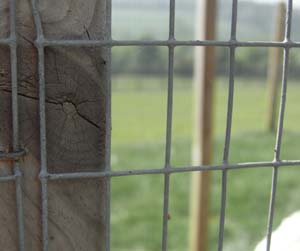 When buying a run, you will need to look at the quality of the wire – small rectangular or square mesh wire is better because foxes can’t get their teeth in to tear at it.
When buying a run, you will need to look at the quality of the wire – small rectangular or square mesh wire is better because foxes can’t get their teeth in to tear at it.
Cheap rabbit wire can be quite thin (especially the cheaper, imported versions from Asia) and I have seen this torn open in weak spots, sadly enough for Mr. Fox to get through. If you decide to use rabbit wire then look for British made, galvanised wire. You certainly ‘get what you pay for’ here but it’s worth doing the job properly.
Latches or bolts to doors are important as well. Galvanised fittings will last years so it is worth paying for these. Screws need to be stainless steel so they don’t rust.
Foxes will dig under a chicken run. If you have problems with foxes during the daytime (or your chickens are not securely locked up in their house at night) then you will need to consider putting your run onto bricks so that Mr. Fox can’t dig underneath. You can put wood chips down inside the run so they can be changed regularly.
There are some smaller runs available that might be customisable to your coop.
Building a Chicken Run
If you are going to build a chicken run, you will need to spend less money but more time. You can of course build a small portable run, much like you would buy and the same things apply to this as I’ve mentioned above but often, people that are building a run go for a fixed run in the corner of the garden.
Rabbit wire is the most economical choice but do be careful with the quality of it. If it isn’t particularly thick, a determined fox will be able to tear at it to get in. a double layer around the lower half of the fence is best if the wire quality is poor.
Ensure that weak points such as where wire joins houses is securely stapled. These areas will need checking regularly for signs of wear and tear. If installed correctly, electric fences are very good at keeping foxes out but on occasions, I’ve seen a run with a fox unable to get out! Sadly the damage has already been done.
Electric fences are not always suitable for every back garden but even in an urban environment where there are people, you can use an electric wire around the top of a fence to stop foxes climbing over.
Chicken wire needs to be burried at least 6 inches with another couple of inches turned outwards but if the soil is loose, you may need to go down 9 inches or more.
A fox can run up a fence (don’t think of a fox being like a dog, they can move more like a cat and can jump and climb really-well) so unless your run has a wire roof, you will need to make the fence at least 6ft high and ideally sloping outwards at the top.
Gates should ideally be made from a solid mesh stapled to a sturdy frame. If this is not possible, at least make sure the gate cannot twist, allowing a predator to get through if pushed in the corners. A fox will easily get through a small hole. If you don’t believe me, go to my page on foxes and watch the film of the fox squeezing under the fence that’s just a few inches off the ground!
Another method of building a large chicken run is to build some ‘chicken run panels’. You can cut all of your wood in one go, with many pieces being the same size. Once you have produced enough panels, you can screw them together making a large run that’s easy to assemble. Keep the panels off the ground so they don’t rot, a brick base on a small strip foundation is perfect but I’ve seen people use rectangular posts on their side and (better) old railway sleepers buried in the ground.
How to Build a Chicken Run
Building a chicken run is really straight forward if you have some basic DIY skills and follow some of the guidance I have given above.
There are a number of chicken run designs that manufacturers use and a few other ‘home made’ runs that are successful. It is difficult to say when a chicken run becomes a ‘fenced off area’ (see my page on fencing chickens if you have a large area to fence off as a run). I tend to call both ‘the chicken run’.
Here, I am going to call the ‘chicken run’ an enclosure that could be 3 to 4 meters long, usually attached to the coop, rather than being ‘around’ the coop and is often covered over.
Start by drawing up the run how you see it in your mind. I like to make notes on my drawing as things pop into my head. This can save you significant time later on if you have thought it through before buying and cutting wood.
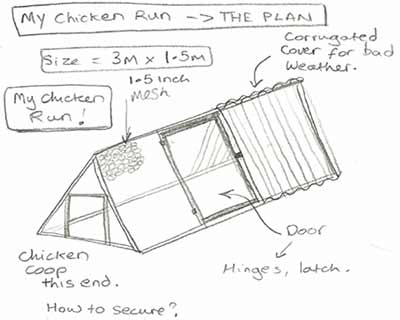 Draw a ‘close up’ of how you are going to make the joints of the chicken run, doors, joint wire and so on.
Draw a ‘close up’ of how you are going to make the joints of the chicken run, doors, joint wire and so on.
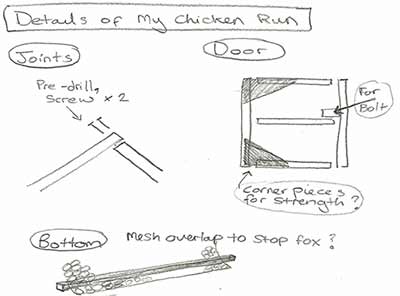 Build a ‘cutting list’ of pieces you will need to build the chicken run. Turn this into a ‘shopping list’ by working out how long your wood needs to be and what sort of thickness you will need. Add hinges, latches, screws, nails, poultry netting and staples to this.
Build a ‘cutting list’ of pieces you will need to build the chicken run. Turn this into a ‘shopping list’ by working out how long your wood needs to be and what sort of thickness you will need. Add hinges, latches, screws, nails, poultry netting and staples to this.
Go and buy your materials, allowing a small amount extra for mistakes!
Chicken Run Plans
One of the best sources of information on chicken runs has been looking through old poultry text books from the 1900’s onwards. These often give chicken house and run plans that have stood the test of time. Many have fold out pages with the plans on so providing you are happy to work in inches and feet, for a couple of searches on eBay and a few pounds, you can soon have quite a few chicken run plans.

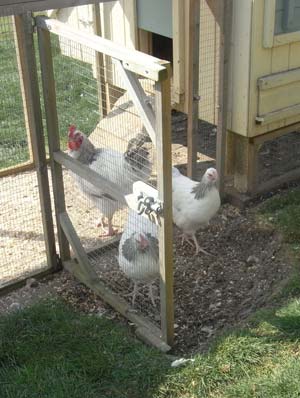
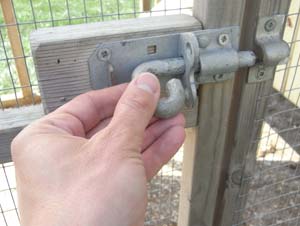



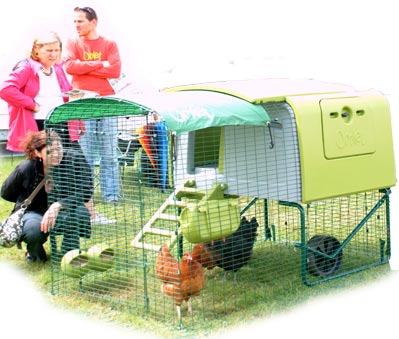


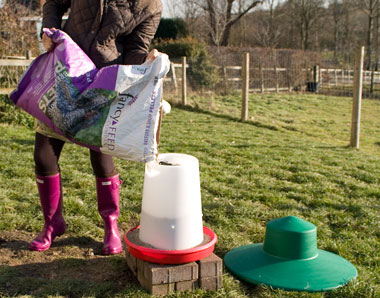
Hi, Can I keep chickens in a garden that is shady and damp? and if so what type of hutch will they need?
You can (they keep hens in barns commercially don’t they) although it would be better if the birds can get some direct sunlight. Vitamin D is made from sunlight but you can give Cod Liver Oil suppliments to help with this and I tend to do this in the winter anyway to help my birds through the cold / dark winter months. All the usual rules apply with the chicken house.
Hi,
Brill site, very helpful.
Ok, I am planning on getting chickens, I have bought a coop for 8 but plan on getting 6 as I know I’ll probably want more. I am also building my own run, the 8ft posts are ordered as is the wire, I plan on sinking the posts 2ft in the ground leaving a 6ft height above ground so I can get in and walk around, I’m also planning on sinking the wire 6inches in the ground, placing bricks on it and then covering it with dirt, and doing a ‘double layer’ of wire to a height of 3ft. The run is going to be 8metres by 5metres (and 6ft high). I’m also planning on putting a wire ‘roof’ on top of the run, so I can put branches in there for fun plus other things. The run’s going to be on grass. I have heard you can put plastic wire on the ground which the grass will / can obviously grow through but will stop the chucks scratching it up, does that sound about right?
If you can tell me if all this sounds ok or give advice it will be much appreciated.
It sounds fine but the only thing I would keep in mind is that the grass will need sun to grow well and for your chickens, scratching is a natural part of their behaviour so inhibiting this seems a little unfair. I would provide a boxed in area if you can for soil where they can dust bath and scratch or maybe wood chippings if you don’t want to use soil.
Hi, thanks for the advice.
Do you think it will be a happy medium if i ‘protect’ half the grass with the soft plastic wire to stop them scratching and leave the rest to be scratched up ?? I actually dont mind all the grass being scratched up, i was only protecting it so the chucks weren’t slopping around in mud all the time and i thought they might like grass between their toes, plus i thought they could find bugs etc crawling around in it to eat.
What do you suggest ??
Many Thanks
Sounds fine – but I would consider using wood chippings or sand on half of the run so they it can be changed from time to time rather than mud that doesn’t look nice and can harbour poultry worms and eggs.
Hi, I’m buying 3 Pekin Bantams for my daughter who’s 6 and have bought an Eglu with an extended run (3m long). I have a big garden and can move the run around in the summer on the grass. I hear that Pekin’s must be kept on dry ground in the winter, due to their feathers rubbing on the ground. What’s best to put on the floor for the winter – a gravel bed, wood chippings, or slabs? Thanks, David
I think with birds that have feathered feet, mud and muck is the enemy so they are best kept in a covered run with dry chippings or sand on the floor that can be changed from time to time. Slabs work but look pretty boring and show all the muck. They also don’t allow chickens to scratch which is one of their natural behaviours although you could provide a smaller area within the slabbed run of chippings for them to scratch in.
Thanks very much, will keep then dry! Wood chippings or sand are better than gravel then? David
Hi
I have 3 ex bat hens that are doing really well. I have had them for about a year. They have the run of the garden but obviously over the winter their time outside is reduced. I have gravel on the floor of the run but despite regular cleaning this has become thick with a layer of chicken poo. Is there an alternative for the floor of the run?
Thanks
Julie
You can use a deep bed system of sand or wood chippings on the floor that can be dug out and replaced periodically.
I have just moved to the country (Devon) and want to keep chickens but since being here I have noticed the ground gets very wet and muddy. I do not have a south facing garden. I am planning to have the garden rotavated and re grassed before I get them. How will the chickens cope with these conditions.
It isn’t good for birds to be in mud and it’s not good for worms, however some mud can be inevitable. If they have some areas to get out of the mud, that will help but also do not consider fancy / feather legged breeds.
If it becomes a problem, it is better to have a small covered run with 6 inches of wood chippings or sand inside to allow scratching and to keep then enclosed on really wet days. I do this with my ducks and geese to stop my runs from turning into a mud bath when it’s really wet.